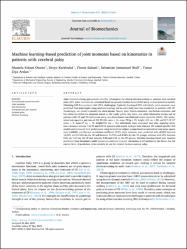Machine learning-based prediction of joint moments based on kinematics in patients with cerebral palsy

Göster/
Erişim
info:eu-repo/semantics/openAccessTarih
2023Yazar
Arslan, Yunus ZiyaÖzateş, Mustafa Erkam
Karabulut, Derya
Wolf, Sebastian Immanuel
Salami, Firooz
Üst veri
Tüm öğe kaydını gösterKünye
Arslan, Yunus Z., Özateş, Mustafa E., Karabulut, D., Wolf, Sebastian I., Salami, F. (2023). Machine learning-based prediction of joint moments based on kinematics inpatients with cerebral palsy. Journal of Biomechanics içerisinde 155.Özet
Joint moments during gait provide valuable information for clinical decision-making in patients with cerebral
palsy (CP). Joint moments are calculated based on ground reaction forces (GRF) using inverse dynamics models.
Obtaining GRF from patients with CP is challenging. Typically developed (TD) individuals’ joint moments were
predicted from joint angles using machine learning, but no such study has been conducted on patients with CP.
Accordingly, we aimed to predict the dorsi-plantar flexion, knee flexion–extension, hip flexion–extension, and
hip adduction-abduction moments based on the trunk, pelvis, hip, knee, and ankle kinematics during gait in
patients with CP and TD individuals using one-dimensional convolutional neural networks (CNN). The anonymized retrospective gait data of 329 TD (26 years ± 14, mass: 70 kg ± 15, height: 167 cm ± 89) and 917 CP (17
years ± 9, mass:47 kg ± 19, height:153 cm ± 36) individuals were evaluated and after applying inclusion–exclusion criteria, 132 TD and 622 CP patients with spastic diplegia were selected. We trained specific CNN
models and evaluated their performance using isolated test subject groups based on normalized root mean square
error (nRMSE) and Pearson correlation coefficient (PCC). Joint moments were predicted with nRMSE between
18.02% and 13.58% for the CP and between 12.55% and 8.58% for the TD groups, whereas with PCC between
0.85 and 0.93 for the CP and between 0.94 and 0.98 for the TD groups. Machine learning-based joint moment
prediction from kinematics could replace conventional moment calculation in CP patients in the future, but the
current level of prediction errors restricts its use for clinical decision-making today.
Kaynak
Journal of BiomechanicsCilt
155Bağlantı
https://www.sciencedirect.com/science/article/pii/S0021929023002373?via%3Dihubhttps://hdl.handle.net/20.500.12846/1000
















